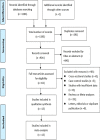A systematic review and meta-analysis of cohort studies on the potential association between NAFLD/MAFLD and risk of incident atrial fibrillation
- PMID: 37476492
- PMCID: PMC10355839
- DOI: 10.3389/fendo.2023.1160532
A systematic review and meta-analysis of cohort studies on the potential association between NAFLD/MAFLD and risk of incident atrial fibrillation
Abstract
Background and objective: The association between atrial fibrillation (AF) and non-alcoholic fatty liver disease (NAFLD) or metabolic-associated fatty liver disease (MAFLD) has been explored in recent cohort studies, however, the results have been controversial and inconclusive. This meta-analysis aimed to explore this potential association.
Methods: We systematically searched PubMed, Embase, and Web of Science databases to identify all relevant cohort studies investigating the association between NAFLD/MAFLD and AF published from database inception to October 30, 2022. Random-effects models were utilized to calculate hazard ratios (HRs) with 95% confidence intervals (CIs) for summary purposes. Additionally, subgroup and sensitivity analyses were performed.
Results: A total of 13 cohort studies with 14 272 735 participants were included. Among these, 12 cohort studies with 14 213 289 participants (median follow-up of 7.8 years) showed a significant association between NAFLD and an increased risk of incident AF (HR = 1.18, 95% CI: 1.12-1.23, P < 0.00001). Our subgroup analyses mostly yielded similar results, and the results of sensitivity analyses remained unchanged. However, meta-analysis of data from 2 cohort studies with 59 896 participants (median follow-up of 2.15 years) showed that MAFLD was not linked to incident AF (HR = 1.36, 95% CI: 0.63-2.92, P = 0.44).
Conclusion: Current evidence shows that NAFLD may be linked to a slightly higher risk of developing AF, particularly among Asian populations and those diagnosed with NAFLD using FLI criteria. Nevertheless, there is not enough evidence to support the proposed association between MAFLD and an increased risk of AF. To better understand this relationship, future studies should consider factors such as specific population, the severity of NAFLD/MAFLD, diagnostic methods of NAFLD and AF, and cardiometabolic risk factors.
Systematic review registration: https://www.crd.york.ac.uk/prospero, identifier CRD42022371503.
Keywords: atrial fibrillation; cohort studies; meta-analysis; metabolic dysfunction-associated fatty liver disease; non-alcoholic fatty liver disease; systematic review.
Copyright © 2023 Zhou, Ju, Mei, Jiang, Wang, Zheng and Ding.
Conflict of interest statement
The authors declare that the research was conducted in the absence of any commercial or financial relationships that could be construed as a potential conflict of interest.
Figures






Similar articles
-
Non-alcoholic fatty liver disease increases the risk of cardiovascular disease in young adults and children: a systematic review and meta-analysis of cohort studies.Front Cardiovasc Med. 2024 Jan 10;10:1291438. doi: 10.3389/fcvm.2023.1291438. eCollection 2023. Front Cardiovasc Med. 2024. PMID: 38268853 Free PMC article. Review.
-
Nonalcoholic fatty liver disease is associated with increased risk of atrial fibrillation.Liver Int. 2020 Jul;40(7):1594-1600. doi: 10.1111/liv.14461. Epub 2020 May 23. Liver Int. 2020. PMID: 32279432
-
Association between non-alcoholic fatty liver disease and risk of atrial fibrillation in adult individuals: An updated meta-analysis.Liver Int. 2019 Apr;39(4):758-769. doi: 10.1111/liv.14044. Epub 2019 Feb 7. Liver Int. 2019. PMID: 30657626
-
Risk of cardiovascular events in patients with non-alcoholic fatty liver disease: a systematic review and meta-analysis.Eur J Prev Cardiol. 2022 May 6;29(6):938-946. doi: 10.1093/eurjpc/zwab212. Eur J Prev Cardiol. 2022. PMID: 34939092
-
Association between non-alcoholic fatty liver disease and risk of new-onset atrial fibrillation in healthy adults.Liver Int. 2020 Feb;40(2):338-346. doi: 10.1111/liv.14236. Epub 2019 Sep 22. Liver Int. 2020. PMID: 31479572
Cited by
-
Common Denominator of MASLD and Some Non-Communicable Diseases.Curr Issues Mol Biol. 2024 Jun 29;46(7):6690-6709. doi: 10.3390/cimb46070399. Curr Issues Mol Biol. 2024. PMID: 39057041 Free PMC article. Review.
-
Non-alcoholic fatty liver disease increases the risk of cardiovascular disease in young adults and children: a systematic review and meta-analysis of cohort studies.Front Cardiovasc Med. 2024 Jan 10;10:1291438. doi: 10.3389/fcvm.2023.1291438. eCollection 2023. Front Cardiovasc Med. 2024. PMID: 38268853 Free PMC article. Review.
-
Machine learning identification of risk factors for heart failure in patients with diabetes mellitus with metabolic dysfunction associated steatotic liver disease (MASLD): the Silesia Diabetes-Heart Project.Cardiovasc Diabetol. 2023 Nov 20;22(1):318. doi: 10.1186/s12933-023-02014-z. Cardiovasc Diabetol. 2023. PMID: 37985994 Free PMC article.
-
Circulating type IV collagen 7S concentrations are associated with left atrial remodeling indices in patients with atrial fibrillation.J Int Med Res. 2025 Feb;53(2):3000605251314832. doi: 10.1177/03000605251314832. J Int Med Res. 2025. PMID: 39973228 Free PMC article.
-
Association of nonalcoholic fatty liver disease with new-onset atrial fibrillation stratified by age groups.Cardiovasc Diabetol. 2024 Sep 12;23(1):340. doi: 10.1186/s12933-024-02408-7. Cardiovasc Diabetol. 2024. PMID: 39267090 Free PMC article.
References
Publication types
MeSH terms
LinkOut - more resources
Full Text Sources
Medical

